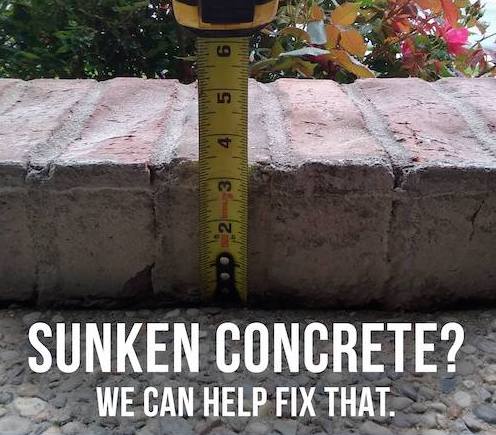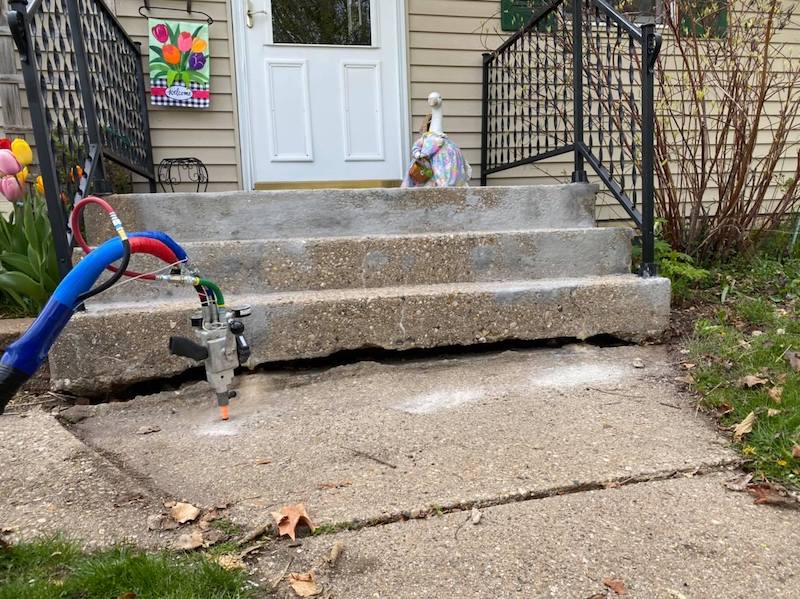Concrete Lifting Frequently Asked Questions

What is concrete lifting and why might I need it?
Concrete lifting is the process of raising sunken or damaged concrete slabs by filling the area underneath them. Concrete that has sunk can happen for a variety of reasons, including erosion, poor drainage, tree roots, and inadequate compaction of soils. At Intelligent Concrete Lifting & Stabilization, we use polyurethane foam to fill voids and lift concrete. This process is also known as “poly leveling,” “poly jacking,” or “slab jacking.”
What types of concrete surfaces can be leveled?
Almost any home concrete surface can be lifted, including driveways, sidewalks, patios, pool decks, garage floors, basement floors, interior floors, warehouse floors, and more. For commercial clients, concrete lifting can be performed on apartment buildings, warehouse floors, loading docks, industrial concrete pads, steps, sidewalks, and more.
How does the concrete lifting process work?
The first step is to drill small holes in the sunken concrete. Next, we insert pipes into the holes and pump polyurethane foam into the area underneath the concrete. The foam expands and lifts the concrete back into place. Finally, we seal the holes and clean up the site. Learn more about the concrete lifting process.
What are the benefits of concrete lifting?
Concrete lifting is a fast, effective, and affordable solution for sunken or damaged concrete. It is also much less disruptive than replacing the entire concrete slab. In addition, the foam we use is environmentally friendly and will not harm plants or animals.
Another benefit of concrete lifting vs. concrete replacement is that your concrete will look more even if you repair rather than replace it. Tearing out and pouring new concrete means that concrete will be several shades lighter than your existing concrete, though normal weathering will even it out over time.
How long does it take to lift concrete?
The entire process usually takes less than a day, depending on the size of the area being lifted. Polyurethane foam is also very quick-drying so you can usually use your concrete surface again later that same day.
What is the difference between poly jacking/poly leveling and mud jacking?
Mudjacking, also known as “slurry jacking,” is an older method of concrete lifting. Mudjacking uses a mixture of sand, clay, and water to fill the voids under sunken concrete. While mud jacking is less expensive than poly leveling, it is also much less effective. The mud in mud jacking can wash away over time, leaving your concrete sunken again. In addition, mud jacking is a very messy process that often leaves behind a large hole in your yard.
Poly leveling/poly jacking is a newer and much more effective method of concrete lifting. We use polyurethane foam to fill the voids and lift your concrete back into place. Polyurethane is much more durable than mud and will not wash away over time. In addition, the holes we drill for poly leveling are much smaller than the ones used for mud jacking.
What are the risks of not repairing sunken concrete?
Sunken concrete can create trip hazards and cause accidents. It can also lead to structural damage to your home or business. For example, concrete surrounding your home (sidewalks, driveways, etc.) should slope away from your home to drive water away. If your concrete becomes uneven, it may drive water toward your foundation, which can lead to dangerous and costly basement moisture issues. If you have sunken concrete, it is important to have it repaired as soon as possible.
Is it more expensive to replace or repair broken concrete?
In most cases, it is cheaper to repair your concrete than to replace it. Concrete replacement can be a very expensive and disruptive process. In contrast, concrete lifting is a fast, effective, and affordable solution for sunken or damaged concrete.
If you have any questions about concrete lifting or want to start a new project, please contact Intelligent Concrete Lifting & Stabilization today.
How much does concrete lifting cost?
Prices vary depending on the size of the area being lifted and the severity of the damage. To get an estimate on your project, please contact us today.

 The first step is to locate the source of the problem. Once we identify the source, we can begin planning the repair. We will then clean out the affected area and prepare it for filling. Next, we will inject high-strength polyurethane foam into the void. The foam will expand and harden, filling the space and providing support to the concrete above. Finally, we will clean up the work area and ensure that the repair is invisible.
The first step is to locate the source of the problem. Once we identify the source, we can begin planning the repair. We will then clean out the affected area and prepare it for filling. Next, we will inject high-strength polyurethane foam into the void. The foam will expand and harden, filling the space and providing support to the concrete above. Finally, we will clean up the work area and ensure that the repair is invisible.